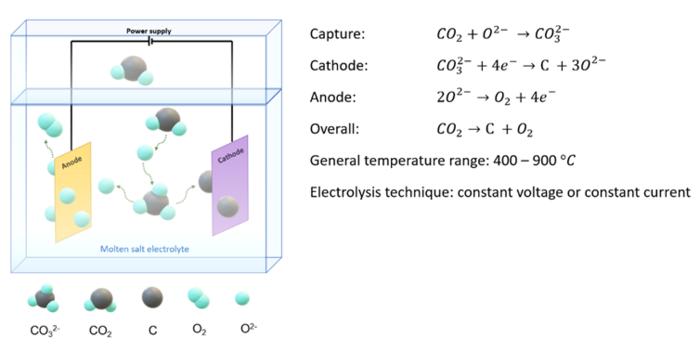Carbon dioxide capture, storage, and utilization have been widely researched to achieve CO2 zero emission and resolve climate change issues. Molten salt electrolysis is one promising method to simultaneously capture and convert CO2 into valuable carbon materials and oxygen with high current efficiencies, to provide a promisingly positive cash flow. However, this method still requires investigation for future scale-up applications. A team of scientists reviews the molten salt CO2 electrolysis’s process mechanisms, the salt selection, and the effects of operating conditions, including temperature and voltage. This work is published in Industrial Chemistry & Materials on Jun. 06, 2023.

Credit: Ying Zheng, Western University, London, Ontario, Canada, and Yimin Zeng, Natural Resources Canada–CanmetMaterials, Hamilton, Ontario, Canada.
Carbon dioxide capture, storage, and utilization have been widely researched to achieve CO2 zero emission and resolve climate change issues. Molten salt electrolysis is one promising method to simultaneously capture and convert CO2 into valuable carbon materials and oxygen with high current efficiencies, to provide a promisingly positive cash flow. However, this method still requires investigation for future scale-up applications. A team of scientists reviews the molten salt CO2 electrolysis’s process mechanisms, the salt selection, and the effects of operating conditions, including temperature and voltage. This work is published in Industrial Chemistry & Materials on Jun. 06, 2023.
“Research on carbon capture, storage and utilization is critical for the current climate change crisis,” Said Ying Zheng, a professor at Western University, London, Ontario, Canada, “In this review, we sorted out CO2 emission sources and discussed the novel molten salt CO2 electrolysis to target carbon simultaneous capture and conversion for power plant flue gas, which is the largest emission site. Multiple operating conditions have been summarized to provide updated information and guidance. An outlook on the challenges and disadvantages is also mentioned for future work.”
This molten salt system presents multiple advantages, including high current efficiency, simper solid separation of produced carbon, engineered carbon nanostructures, and positive cash flow. The main components in the electrolysis system are electrolytes, cathode, and anode. Carbonates are preferred as electrolytes to hold better CO2 absorption ability and higher current efficiency compared to chlorides. To avoid metal deposition side reactions and to achieve lower melting points, lithium, sodium, and potassium carbonates are widely combined and used. Additives, especially oxides, are commonly added to increase gas sorption in chlorides and also impact carbon nanostructures with various additives’ materials and amounts. Cathode materials are also able to influence carbon morphologies, and popular choices are Fe, Ni, Pt, their metal oxides, and alloys. Anode usually utilizes materials with strong durability and anti-corrosion ability, such as metal oxides and alloys for oxygen evolution. Temperature and voltage are the two significant operating parameters as they control the activation energy of the electrolysis. Higher temperature suppresses carbon formation but improves CO production. Constant current or constant voltage electrolysis are the major techniques used for the electrolysis system. The study of voltage focuses on not only electrolysis potentials but also energy consumption.
However, molten salt CO2 electrolysis leaves some research gaps. The first challenge is system scaling up as current research is conducted on the lab scale. Also, the study of corrosion on electrodes and equipment should be investigated under electrolysis, high operating temperatures, and liquid carbonates. The durability and continuity of continuous operation of the electrolysis system have not been reported yet. The engineering analysis has not been thoroughly performed to provide more information for future commercialization, including a whole process flow design, mass and energy balance, economic analysis, etc. Other challenges can be the design of the electrodes’ surface area and shape, uniform carbon morphology, carbon deposition rate research, gas impurities, and more.
Professor Ying Zheng said: “In this review, the main goal is to update current studies on molten salt electrolysis, covering its purposes, advantages, mechanisms, novel research outcomes, and future investigation outlook, in the field of CO2 capture and conversion.”
The authors would like to acknowledge the financial support received from Natural Resources Canada (NRCan) CCUS program and Western University Ontario.
Industrial Chemistry & Materials is a peer-reviewed interdisciplinary academic journal published by Royal Society of Chemistry (RSC) with APCs currently waived. Icm publishes significant innovative research and major technological breakthroughs in all aspects of industrial chemistry and materials, especially the important innovation of the low-carbon chemical industry, energy, and functional materials.
Journal
Industrial Chemistry and Materials
DOI
10.1039/D3IM00011G
Method of Research
Literature review
Subject of Research
Not applicable
Article Title
Overview of CO2 capture and electrolysis technology in molten salts: operational parameters and their effects
Article Publication Date
6-Jun-2023




